Osteoporosis
Osteoporosis, or porous bone, is a bone disorder characterized by low bone mass and structural deterioration of bone tissue, mainly because of hormonal changes. The bones lose calcium and phosphate salts and become fragile and vulnerable to fractures. The only way to diagnose osteoporosis before a fracture happens is by a bone density test.
[/vc_column_text]
[/vc_column][/vc_row]Bones:
Bones are alive and continuously changing, storing minerals, forming blood cells and provide a strong and solid structure that can protect organs and act as an attachment for muscles and ligaments. There are two main types of bones, cortical and trabecular.
Cortical bone is arranged in long, parallel, compact lines and found in the long bones of the femur, tibia, humerus, radius and ulna.
Trabecular or cancellous bone is sponge-like and found in the vertebral bodies, in the neck of the femur (hip) and at the joint surfaces of all bones. Trabecular bone has an 80% faster metabolic turnover rate than cortical bone and therefore has greater chance for osteoporosis. Luckily, trabecular bone makes up only 20% of our total skeletal mass, whereas cortical bone makes up the remaining 80%.
It is known today that a healthy lifestyle, balanced diet and regular exercise are very important to keep prevent osteoporosis.
Who is at Risk?
- Asian or Caucasian descent
- Genetic
- Early menopause (before age 45)
- Irregular or no menstrual period
- Removal of the ovaries
- Smoking
- Small frame size or underweight
- History of bone density reducing drugs
- Inadequate calcium and vitamin D intake
- Eating disorders
- High intake of salt and animal protein, caffeine, alcohol, soft drinks, sodium, sugar & fiber
Symptoms:
In the early stages of osteoporosis, there are usually no symptoms. Once bones have been weakened by osteoporosis, symptoms may include:
- Back pain
- Loss of height over time
- Extreme kyphosis
- A bone fracture that occurs much more easily than expected
Pilates and Movement:
Like muscles, bones are a living organ and have the ability to respond to exercise. Research has shown that exercises alone can halt the progression of osteoporosis. (Smith & Gilligan 1987)
The best way to exercise the bones is with closed chain (weight bearing) exercise. Walking, hiking, dancing, racket sports, aerobics, Pilates etc. are all effective in increasing bone mass. Swimming and cycling are example of open chain exercises.
Recommended:
If the student is 45 years or older (or younger and has gone through menopause), inquire if they had a bone density test. If you dont have information assume there is osteoporosis.
- Emphasize spinal extension
- Closed chain work
- Challenge the musculoskeletal and neuromuscular systems with a variety of movements
- Strengthen muscles around the joints
- Enhance core connection
- Emphasize lengthening
- Strengthen wrists and shoulder girdle
- Strengthen hips and legs
- Improve connection to the feet
- Strengthen the spine
- Isometric core exercises
- Balancing exercises
- Postural exercises
- Coordination exercises
- Work with weights, bands and magic circle
- Modify, modify, modify
- Work in small range of motion first, increase gradually and safely
- Gradually increase weight


